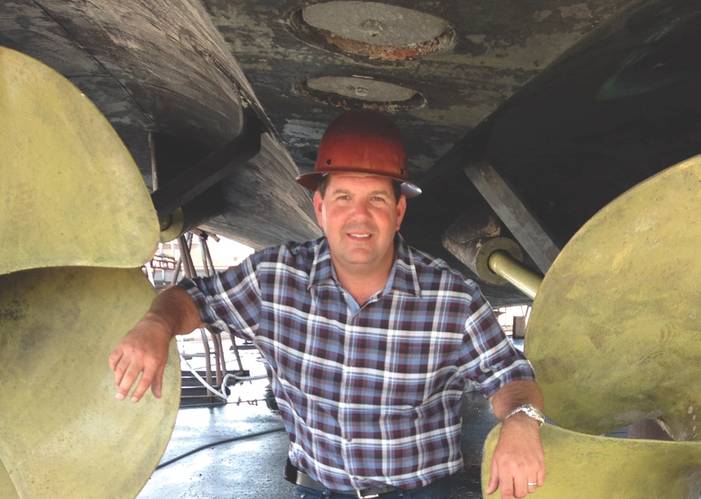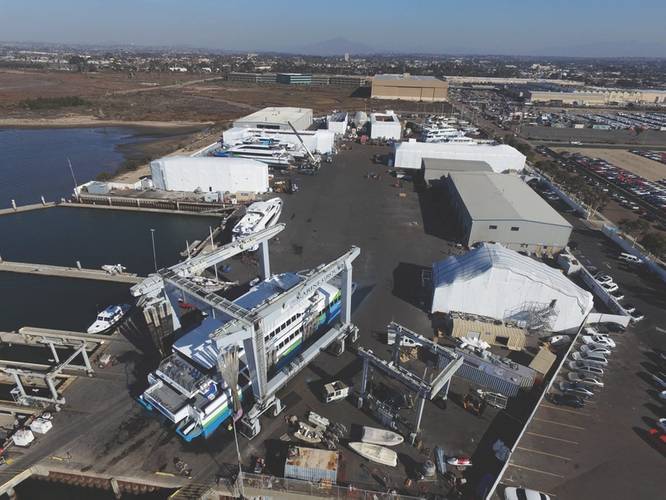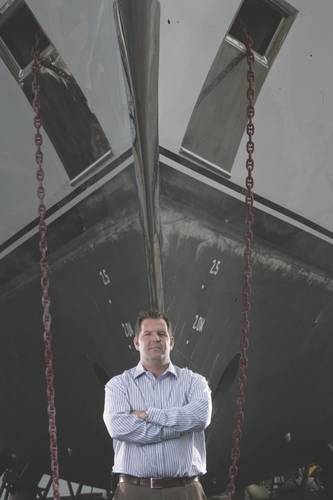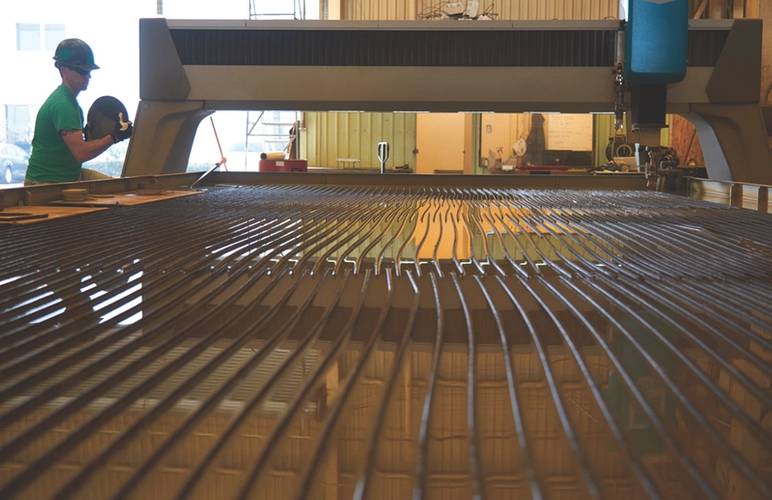From growing up on San Diego Bay then graduating from the California Maritime Academy to leading a fast-growing, technologically advanced, family-owned group of shipyards, Todd Roberts, for as many of his 43 years that he can remember, has always been ‘maritime.’
"As a kid, I worked for our sister company, Flagship Cruises (formerly San Diego Harbor Excursion),” said Roberts. “I wanted to be a deckhand on the ferry but I was told that I was too young, so I started out sweeping the floors in the boathouse, and doing just about anything, from loading the boats to hauling line. Going to work for me was like other kids going to the Little League field. This is where I wanted to be; this is what I wanted to do."
And so starts the story of Todd Roberts’ maritime career some three decades ago. Roberts graduated Cal Maritime, and after nearly two years of sailing various commercial vessels, he knew that his maritime future lie ashore. “I graduated in 1995 with a degree in business administration and marine transportation, which was a new program at the time. As usual Cal Maritime was 15 years ahead of the curve, realizing that it didn’t need to graduate only mariners, but mariners with a business sense,” said Roberts. “I always had an entrepreneurial spirit and a head for business, and going to sea you can only do so much in controlling the operations of a ship.”
But after coming to shore and working as a port captain and broker for bulk cargo ships coming out of San Diego, he was bored at work. His career trajectory changed for good when he ran into the president of the company he used to sweep floors for less than 20 years earlier—also the co-owner of Marine Group. Eventually he was offered the position of Director of Operations for the company’s San Diego Harbor Excursion operations, running 10 boats carrying more than a million passengers per year.
During his tour as the Director of Operations, his duties included the usual – supervising vessel construction, acquisition and operations – as well as the cutting edge: Emissions trading and the sale of NOX credits to local power companies, not a common practice in the year 2000.
“We created a system of taking surplus emissions from vessels, reducing vessel emissions and selling those (NOX credits) on the open market to power companies — a very exciting project,” said Roberts. But even with this workload, Roberts had time to invest in other projects, so he went to the owner and said “if there’s something else you have cooking, let me know.”
Closing a Shipyard
One of the company’s holding was a shipyard in Chula Vista that wasn’t doing great, so Roberts – now still in his late 20’s – was sent in to shut it down in 2001 to make way for a proposed hotel construction project. In his words the owners were ‘done with it’, and the mandate was to lay off 60 workers to start, and finish any work that was still open. But Roberts, who had never before managed a shipyard, noticed a ‘megayacht vibe’ proliferating in Southern California. That, combined with the fact that the proposed hotel project was ensnared in a quagmire of regulatory red tape, prompted him to approach ownership with the notion of providing a “Quickie Lube” for yachts, following the land-based automotive trend.
“The proposal was that we would haul your boat on Monday, we would limit our work to shafts, propellers and bottoms, and your boat leaves on Thursday,” said Roberts. “With a fixed price and three trades, we became efficient very quickly and we started to expand, picking up some Navy business.”
With success in hand, Roberts went back to ownership for additional financing to turn the Chula Vista yard into a full-fledged superyacht facility. Ownership essentially said ‘here’s a fixed amount, good luck, not a nickel more; and if it doesn’t work, send everyone home.’
Nearly a decade later, the business where he saw value continues to grow in earnest, with three facilities (Chula Vista, Calif.; National City, Calif. and Los Cabos, Mexico) and a growing portfolio of repair, refit and new construction for commercial and government/military clients.
Of the $7 million invested at the time, Roberts counts the 660-ton Travelift as the key investment, remembering “the day we put that machine into service there was no looking back. We booked our first year in the first three months … it was the epitome of ‘if you build it, they will come’; the central player was the lift capacity,” said Roberts.
MGBW: The Modern Shipyard
By virtue of Roberts’ diverse background in the marine business, he never pigeonholed himself or his company as a ‘yacht yard’ or as a ‘tugboat yard.’ You have workboat yards that want nothing to do with the white hulled ‘foo foo’ boats, and vice versa, you have yacht yards that don’t want ‘smelly workboats’ in their yard, he said “They’re all the same to me. I don’t care, I love them all.”
Love is one thing, performance another, and Roberts and his team take ‘keeping to schedule’ to a new level.
“The megayacht market is so discerning you have to have an insatiable level of detail work; you can’t screw up, there is no ‘sorry.’ Roberts said that he learned the value of ‘on time’ early on, when a famous yacht owner in late 80’s told him ‘Young man, I have more money than time. Don’t be late.’
“I’ll never forget that comment. That’s the mantra we live by: Honor your commitments, stay on your schedule.”
By word of mouth commercial tug and barge owners saw the yard’s lift capacity and started inquiring, and according to Roberts he and his team are always up for a good challenge. “We love when people doubt our capability to do something. (I tell them) “if it doesn’t work and I’m wrong, I’ll give you your money back, we’ll shake hands and we’ll part friends. We haven’t failed yet,” said Roberts, who today runs the operation and owns a minority share.
Looking back from when it started to today, he can see the obvious changes, but also the similarities.
“It’s most different by the size and complexity of the jobs that we do. The biggest change, arguably, came with the addition of new construction capability. It’s most the same by the passion and integrity of the people who work here. We still have that craftsmanship mentality. That spirit penetrates the yard, and I must admit that’s both good and bad. It’s good because it mixes some love into the recipe; when you’re making the cake, you can follow the directions all that you want, but there’s a little love in mom’s cooking. The downside is we’re working on more complex vessels, we’re working on specifications that are very tight, and sometimes craftsman want to do it their way. You have to take that craftsmanship and love and blend it with technology. When you have a catamaran that’s carrying 350 people at 30 knots, when they meant a 1 x 6 angle they didn’t mean a 1 x 6.25 angle.”
To that end MGBW has a progressive view toward investment. Our investment strategy is an investment in technology capacity Roberts said. “We buy the tools we need to do the job and grow the business. There is no hard and fast “Capital Improvement Budget;” whatever we need, if we can make a good sense of it, we’ll buy it. This philosophy was fast-tracked during the (economic) downturn, when sub-suppliers slowed down and caused some delays.”
Recent investments include a 10-ton gantry crane (bought with help from MarAd’s small shipyard assistance grant program) for use in fabrication shop to make newbuilding more efficient. The company also upgraded its waterjet cutting table to handle a 10 x 40 sheets of material, meaning bigger pieces and less welding.
“We struggled with outsourcing and vendors dropping the ball on us, so we decided to control our own destiny and cut our own parts.” The yard also invested in a same-size plasma cutting table to cut its own steel in an efficient manner, as well as sandblasting capability; and in its National City yard a new 70-ton hydraulic trailer for moving modules in and out of the fabrication building as well as two new docks. All of these tools are critical to maximizing efficiencies and keep schedule.
But arguably the purchase which Roberts is most proud … the “Crowning achievement which is the least fun to buy but the most fun to have,” is its $3m, 500 kW solar system at its National City building, allowing it to produce about 2/3 of its own power and driving the company toward a “Zero Emission Facility.” (See related story next page).
With 217 people across three yards, an armada of cutting edge technology, and a growing market in Southern California, Roberts is happy to discuss what he views as a good contract:
“What’s a good job for us? It’s profitable and a win-win situation. If it’s not good business for either side, you don’t want to be here and frankly, we don’t want you here. There is no magic in boat repair.”
Todd Roberts on:
The Market Today:
I think the market is very healthy. I think it is healthy for yards that are willing to accept technology and innovate.
Running a shipyard in California:
In shipbuilding there is a leveling of the competition (globally). The only thing that knocks the level away is the state of California (and the extra expenses that come with environmental regulatory compliance). But there are benefits to a shipyard operating in California: our environmental requirements are unprecedented in the world, and they exceed any yard in the U.S. It creates a cleaner, more productive environment … we can overcome environmental regulations and the result, in my opinion, is a better product. You can’t tell me that welding aluminum in a dirt lot that you’re not going to have contamination.
The Adoption of Technology:
A lot of the environmental regulatory requirements transition into quality, and we are forced to innovate. We have to lean on technology, we have to look at everything and think ‘How can we cut these pieces more efficiently’ … ‘Where can we bend and break instead of weld’
His Greatest Challenge:
Finding and keeping a qualified workforce. The biggest struggle we have is finding qualified labor, and you wouldn’t think that in a big navy town like San Diego. Roberts said a successful MGBW employee is one that is flexible and cross trained, able to work projects on the repair or new construction sides, yacht, commercial or navy. “Some folks can do it, some cannot. The ones that can are very successful, and the ones that cannot are not. I refuse to put folks in pews and limit their work scope. Our reluctance to do that has been a key to our success.”
Solar-Powered Boatbuilding: Marine Group Boat Works Moves Toward a Zero-Emission Shipyard
Marine Group Boat Works, LLC, completed a 500 kW rooftop solar panel system for its shipyard in National City, Calif., making it reportedly first boatbuilder to use solar energy to construct boats. “Our initial decision to go solar was driven primarily by our desire to be a zero-emission, low impact boatbuilder,” said Todd Roberts, president of MGBW. “There’s no question that solar is an economic benefit, but there are many other advantages – everything from self-reliance and sustainability to doing the right thing.” The new solar panel system will decrease MGBW’s footprint and is expected to reduce annual energy consumption by 81% based on past and projected consumption. While MGBW has wanted to go solar for the past several years, energy consumption from boat repair was simply not great enough to warrant the investment. However, since MGBW opened its new construction division, increases in manufacturing and Solar panel installation helps San Diego boatbuilders Marine Group Boat Works, LLC power the construction of boats for the Navy. Baker Electric Solar, San Diego, was selected to design and install the 500 kW rooftop solar panel system for MGBW. The total cost was $1.2m, and the new system reportedly will provide more than $3m in net savings over 25 years, with return on the initial investment in about five years.


















